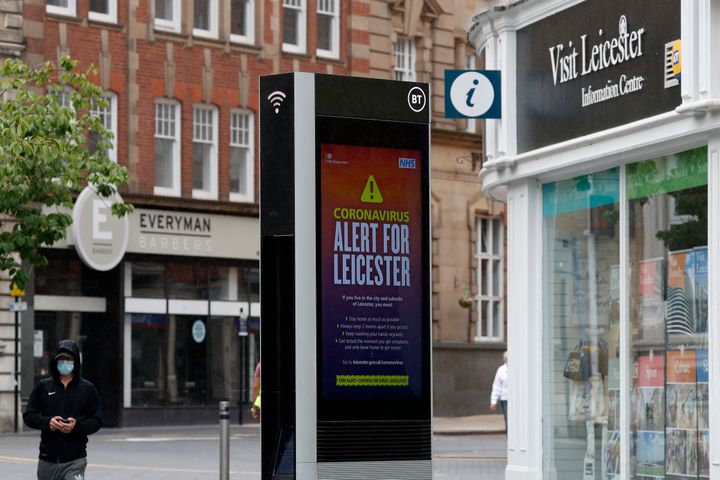
Get the latest on coronavirus. Sign up to the Daily Brief for news, explainers, how-tos, opinion and more.
Leicester has seen a spike in cases of coronavirus, sending authorities scrambling to put the East Midlands city under lockdown.
Barely two weeks after reopening, non-essential shops have once again shut their doors and schools will be closed to most pupils from Thursday, while people have been advised against all but essential travel.
On Monday, health secretary Matt Hancock told the Commons the city had recorded 10% of all positive Covid-19 cases in the country this week. Some 658 new cases were recorded in the two weeks up to June 16.
After analysing figures released by Public Health England, Leicester City Council has estimated nearly 450 of the 658 cases were in the north and east of the city. However, public health officials have said it appears that there is no “single point source” for the outbreak.
The five council ward areas with the highest numbers of positive coronavirus cases were North Evington (118), Humberstone and Hamilton (52), Belgrave (45), Spinney Hills (41) and Rushey Mead (35).
On June 8, Humberstone Academy in Humberstone was forced to close its two schools after a teacher tested positive for coronavirus. The schools reopened but shortly closed again after its headteacher was informed of more positive tests.
A primary school in Evington closed “indefinitely” a few days later on June 12, after a member of staff tested positive for coronavirus. Krishna Avanti Primary School’s principal, Denham Kite, told HuffPost UK no other staff members or students had since come forward with positive tests.
HuffPost UK also spoke to several Leicester locals who pointed to the number of factories in Highfields, near Spinney Hills, some of which have come under fire this week for allegedly forcing employees to work even when they were sick.
A report from the campaign group Labour Behind the Label revealed workers from some garment factories in Leicester had been told to continue to report for duty. The group has also alleged that these “vulnerable” workers face “illegal working conditions” and pay of as little a £3 an hour.
At least five garment factories in Leicester have closed due to outbreaks of coronavirus among workers, the Mirror has reported.
One Leicester local whose family previously worked in the garment factories told HuffPost UK he “wouldn’t be at all surprised” if the rise in coronavirus cases was linked to the factories. He described poor working conditions and long hours for workers, many of whom would be “off the books” and work in several sites at the same time.
Elsewhere, the snack company Walkers confirmed on Wednesday there have been 28 positive cases of coronavirus in its factory in the Beaumont Leys area of Leicester.
This followed the news that “a handful or so” of workers at a Samworth Brothers sandwich factory in Beaumont Leys and five employees from the Pladis biscuit factory in South Wigston had contracted coronavirus.

The demographics of the city are another strong possible factor to explain the spike in cases. The north and east of Leicester – the epicentre of this local outbreak – consist of streets of tightly-packed housing with a high proportion of ethnic minority families, where multi-generational living is more common.
The Indian community make up the largest ethnic minority group in Leicester, with many people in eastern parts of the city of Belgrave, Spinney Hills and Rushey Mead.
Professor Kamlesh Khunti, a diabetes and vascular medicine expert at the University of Leicester, grew up in Spinney Hills. “Spinney Hills and North Evington are two predominantly Asian areas,” he told HuffPost UK. “There are higher rates of chronic diseases such as hypertension and cardiovascular disease [conditions where patients are more vulnerable to contracting Covid-19] and people are often living in multigenerational housing.”
“Many are poor or working essential jobs. They may have had to continue their jobs this entire time, putting them at risk of catching the virus and bringing them back to their own community.”
However he was keen to stress there was no way to pinpoint why there has been a spike in coronavirus cases. “All of us have hearsay like [the reports of factory workers being forced to come in],” he said. “There are all sorts of rumours but I don’t think anyone knows what the key reasons are.”
He added there might not even be a “true increase” in coronavirus cases. “It might just be that the level of testing has increased. We can certainly see a lot more testing of people happening.”
The local health charity Healthwatch told HuffPost UK they were unable to speculate on specific causes of the local outbreaks, however they also pointed to North Evington and Highfields as having “a densely populated demographic”, with “a strong BAME community” - a group that has already been shown to be disproportionately affected by the virus.
They added it was crucial “public health messages must be accessible to all and overcome any language/communication barriers.”
Professor Mike Barer, also from the University of Leicester, told HuffPost UK there was “a strong impression that some groups were missed out by the public messaging”.
Certainly within some minority groups, there have been fears that lockdown messaging has not properly reached people who do not speak English as a first language. In Spinney Hills, 18% of the population were recorded as not speaking English well in 2013.
It has also emerged that Leicester City Council had to wait for days for coronavirus test data before being locked down, which Labour leader Keir Starmer said led to a “lost week” while the virus spread in the city.
Professor Khunti said he was “taken aback” when he first heard Leicester was being put under local lockdown. “The news about the spike came to us a few days late,” he said. “Locally we needed to get that data in real time.
“It has to be a local issue; local people know the area, they know the networks. We’ve got faith leaders, business leaders pushing the message so people don’t feel alienated and scared to come forward to get tested.”
